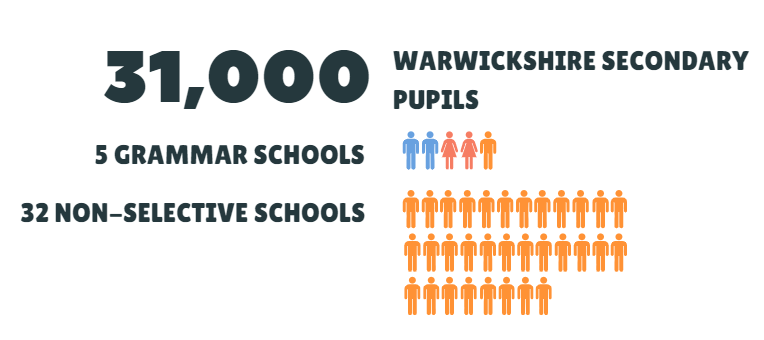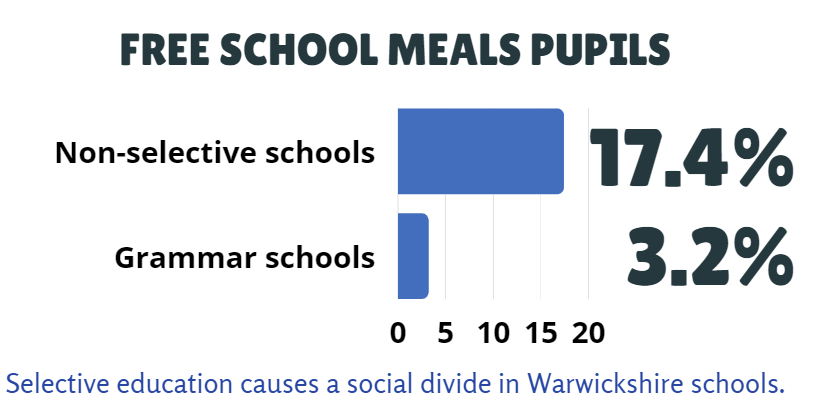 Selective education guide – Warwickshire
Selective education guide – Warwickshire
BACKGROUND
There are 5 grammar schools in Warwickshire and 32 non-selective schools. Check out our map of selective schools in England to find out more about individual schools. The map details the percentage of disadvantaged pupils, percentage of privately educated ‘prep school’ pupils, and the relative selectivity of every grammar school in Warwickshire. View the map HERE.
Or, to read stories from parents and teachers experiencing selective education in Warwickshire visit the 11+ Anonymous website HERE.
THE PROBLEMS
In every area where academic selection still exists there are some common problems. For example,
- Grammar schools admit fewer disadvantaged pupils than non-selective schools. Grammar schools are also more likely to admit pupils from more advantaged families.
- A significant number of pupils previously educated in fee-paying ‘prep’ schools take up grammar school places. As many as 19% of pupils in some Warwickshire grammars were previously educated in the independent sector. In England 5% of primary pupils attend private schools, so this is not a typical balance of pupils.
- Tuition for the 11-plus ‘buys advantage’. Better-off families can afford private coaching while poorer families may feel compelled to pay for tuition they can ill afford.
- Sitting the 11-plus is stressful and can damage a child’s confidence.
- The 11-plus has been proven to lack accuracy because it takes place while children are still developing academically.
- Research shows the proportion of children with Special Educational Needs (SEN) attending grammar schools is small. For many children with additional learning needs such as dyslexia and attention deficit disorders, the 11-plus test is inaccessible. The same children often perform very well academically outside a test situation.
- Grammar schools change the pupil profile of other schools in the area. If a large number of higher attaining pupils attend grammar schools then surrounding schools find themselves with a pupil population which is skewed, with a disproportionate amount of moderate and lower attaining pupils and pupils with additional learning needs. This impacts on subject choice (fewer subjects available than at a grammar school) and teacher recruitment. Non-selective schools in areas with grammar schools cannot be ‘true’ comprehensives and tend to underperform compared to comprehensive schools.
- GCSE results in areas with grammar schools are on a par with, or worse, than areas that have only comprehensive schools. Research has shown that children who attend selective schools would achieve broadly the same results if they attended a non-selective school.
The percentage of pupils attending grammar schools in Warwickshire
Just 10% of pupils in Warwickshire attend a grammar school. Although Warwickshire educates relatively fewer secondary pupils in a grammar school compared to some selective areas, this small proportion still impacts other schools.
A social divide in Warwickshire secondary schools
In common with all grammar schools, disadvantaged pupils are underrepresented in Warwickshire’s grammar schools. As a consequence, non-selective schools located near each of the county’s five grammar schools educate a greater proportion of pupils on free school meals.
The 11-plus damages children’s confidence
Many children feel demotivated by a ‘fail’ in the 11-plus. We believe all children should start secondary school feeling positive about their academic ability. The success of non-selective schools in most areas of the country proves that there is no need to divide children by using an outdated and discredited test.
More information
Warwickshire’s five grammar schools are: King Edward VI School in Stratford-upon-Avon (boys only), Stratford Girls’ Grammar School in Stratford-upon-Avon (girls only), Alcester Grammar School in Alcester (boys and girls), Lawrence Sheriff School in Rugby (boys only), and Rugby High School in Rugby (girls only). In addition, Ashlawn School in Rugby is partially-selective. This school allocates 12% of places to pupils who pass the 11-plus. Thereafter, these pupils are educated in a separate set.
You can find out more information about Warwickshire grammar schools and the 11-plus by visiting the Grammar Schools in Birmingham website. Warwickshire and Birmingham schools are collectively part of a consortium called “The Grammar Schools in Birmingham”. They share the same test which takes place on the same date.
Want to end the 11-plus in Warwickshire?
Join Comprehensive Future’s campaign to end the 11-plus.
To learn about the data sources for our interactive map and selective education guides click here. If you spot any errors in the data for any area, please let us know.



